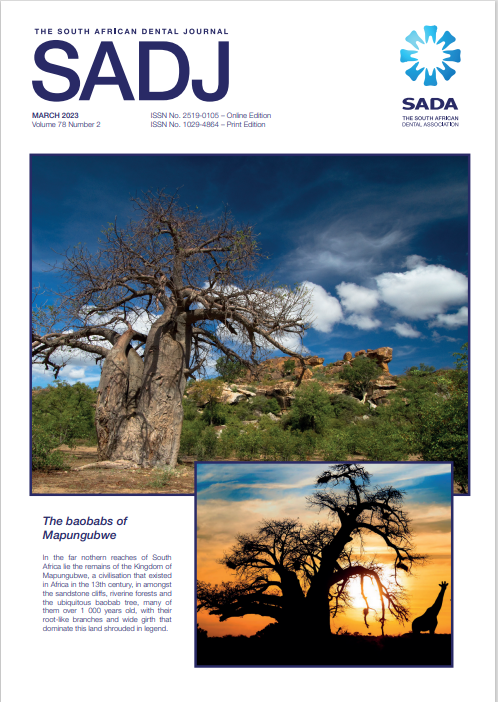An innovative digital workfl ow for the fabrication of a prosthetic ear: A case report
DOI:
https://doi.org/10.17159/sadj.v78i02.16165Keywords:
Maxillofacial prosthetics, Auricular prosthesis, Digital impression, Computer-aided design/computer-aided manufacturing (CAD/CAM), Rapid prototyping, Standard Tessellation Language (STL)Abstract
The aim of maxillofacial rehabilitation is to provide suitable prostheses for patients with oro-facial defects, and enable them to resume their roles in society. Recent advances in bionics and prosthetics have combined different techniques to help in the production of aesthetic and functional prostheses. Technology can now supplement the freehand sculpting skills of the clinician by capturing accurate images of the soft tissues from both the defect and non-defect areas, and using these to digitally recreate the desired
templates. This case report describes the digital steps used to capture necessary data for the design and fabrication of an auricular
template, and fi nal ear prosthesis. Results from this case study suggested that the digital method is: 1) more accurate; 2) less time-consuming than traditional methods; and 3) less invasive, and thus more accepted by patients.
Downloads
References
Singh A, Ghosh S, Kar S, Ahmed I. Silicone prosthesis for a patient with unilateral ear defect: A Clinical case report. Eur J Gen Dent. 2013; 2: 315-9. DOI: https://doi.org/10.4103/2278-9626.115997
Hatamleh M, Haylock C, Watson J, Watts D. Maxillofacial prosthetic rehabilitation in the UK: A survey of maxillofacial prosthetists’ and technologists’ attitudes and opinions. Int J Oral Maxillofac Surg. 2010; 39: 1186-92. DOI: https://doi.org/10.1016/j.ijom.2010.08.002
Bi Y, Zhou M, Wei H. Digital workflow for auricular prosthesis fabrication with a negative mold. J Prosthet Dent. 2022. DOI: https://doi.org/10.1016/j.prosdent.2022.05.022
Watson J, Hatamleh M. Complete integration of technology for improved reproduction of auricular prostheses. J Prosthet Dent. 2014; 111: 430-36. DOI: https://doi.org/10.1016/j.prosdent.2013.07.018
Wang RR, Andres CJ. Hemifacial microsomia and treatment options for auricular replacement: a review of the literature. J Prosthet Dent. 1999; 82: 197-204. DOI: https://doi.org/10.1016/S0022-3913(99)70156-3
Coward TJ, Richards R, Scott BJ. Development of a Morphing Technique for Predicting the Position and Size of an Artificial Ear in Hemifacial Microsomia Patients. Int J Prosthodont. 2014; 27(5): 451-57. DOI: https://doi.org/10.11607/ijp.3990
Ballo AM, Nguyen CT, Lee VS. Digital workflow of auricular rehabilitation: A technical report using an intraoral scanner. 2019. J Prosthodont 28: 596–600. DOI: https://doi.org/10.1111/jopr.13057
Taylor TD, editor. Clinical maxillofacial prosthetics, Volume 1. Chicago: Quintessence; 2000.
Mohammed IM, Tatineni J, Cadd B, Peart G, Gibson I. Advanced Auricular Prosthesis Development by 3D Modelling and Multi-material Printing. InDesTech 2016: Proceedings of the International Conference on Design and Technology. 2017; 37-43. DOI: https://doi.org/10.18502/keg.v2i2.593
Hooper SM, Westcott T, Evans PLL, Bocca AP, Jagger DC. Implant-supported facial prostheses provided by a maxillofacial unit in a U.K. regional hospital: Longevity and patient opinions. J Prosthodont. 2005; 14(1): 32-8. DOI: https://doi.org/10.1111/j.1532-849X.2005.00004.x
Mathews MF, Sutton AJ, Smith RM. The auricular impression: An alternate technique. J Prosthodont. 2000; 9(2): 106–9. DOI: https://doi.org/10.1111/j.1532-849X.2000.00106.x
Suaste-Gómez E, Roldan GR, Cruz HR, Jimenez OT. Developing an ear prosthesis fabricated in polyvinylidene flouride by a 3D Printer with sensory intrinsic properties of pressure and temperature. Sensors. 2016; 16(3): 332 DOI: https://doi.org/10.3390/s16030332
Coward, TJ, Watson, RM, Wilkinson, IC. Fabrication of a wax ear by rapid-process modeling using stereolithography. Int J Prosthodont. 1999; 12(1): 20-7.
Al Mardini M, Ercoli C, Graser GN. A technique to produce a mirror-image wax pattern of an ear using rapid prototyping technology. J Prosthet Dent. 2005; 94(2): 195-98. DOI: https://doi.org/10.1016/j.prosdent.2005.04.019
Technovent. Spectromatch Systems. Technovent Catalogue [Internet]. 2020; www.technovent.com Accessed
Liu H, Bai S, Yu X, Zhao Y. Combined use of a facial scanner and intraoral scanner to acquire a digital scan for the fabrication of an orbital prosthesis. J Prosthet Dent. 2019; 121(3): 531-34. DOI: https://doi.org/10.1016/j.prosdent.2018.05.019
Elbashti ME, Sumita YI, Kelimu S, Aswehlee AM, Awuti S, Hattori M, Taniguchi H. Application of digital technologies in maxillofacial prosthetics literature: A 10-year observation of five selected prosthodontics journals. Int J Prosthodont. 2019; 32(1): 45-50. DOI: https://doi.org/10.11607/ijp.5932
Kim M, Lee J, Shin S. Fabricating an obturator using rapid prototyping to design the framework: A case report. Int J Prosthodont. 2014; 27(5): 439-41. DOI: https://doi.org/10.11607/ijp.3838
Azari A, Nikzad S. The evolution of rapid prototyping in dentistry: A review. Rapid Prototyp J. 2009; 15(3): 216-25. DOI: https://doi.org/10.1108/13552540910961946
Eggbeer D. The computer aided design and fabrication of facial prostheses [thesis]. Cardiff, UK: University of Wales Institute; 2008.
Taniguchi H, Sumita YI, Otomaru T, Minamisawa N, Inohara K. Maxillofacial prosthodontics-current treatment and research. Prosthodont Res Prac. 2008; 7: 132-34. DOI: https://doi.org/10.2186/prp.7.132
Soriano CM, Vega PC, Devesa AE, Salas EJ, López JL. Frequency and type of digital procedures used for the intraoral prosthetic rehabilitation of patients with head and neck cancer: A systematic review. J Prosthet Dent. 2022 [Epub 2021 January 09]; 127(5): 811-15. DOI: https://doi.org/10.1016/j.prosdent.2020.11.025
Farook TH, Jamayet NB, Abdullah JY, Rajion ZA, Alam MK. A systematic review of the computerised tools and digital techniques applied to fabricate nasal, auricular, orbital and ocular prostheses for facial defect rehabilitation. J Stomatol Oral and Maxillofac Surg. 2020; 121: 268-77. DOI: https://doi.org/10.1016/j.jormas.2019.10.003
Tam CK, McGrath CP, Ho SMY, Pow EHN, Luk HWK, Cheung LK. Psychosocial and quality of life outcomes of prosthetic auricular rehabilitation with CAD/CAM technology. Int J Dent. 2014. DOI: https://doi.org/10.1155/2014/393571
Suresh N, Janakiram C, Nayar S, Krishnapriya VN, Mathew A. Effectiveness of digital data acquisition technologies in the fabrication of maxillofacial prostheses–A systematic review. Journal of Oral Biology and Craniofacial Research. 2022 Jan 1;12(1):208-15. DOI: https://doi.org/10.1016/j.jobcr.2021.12.004
Downloads
Published
Issue
Section
License

This work is licensed under a Creative Commons Attribution-NonCommercial 4.0 International License.






.png)